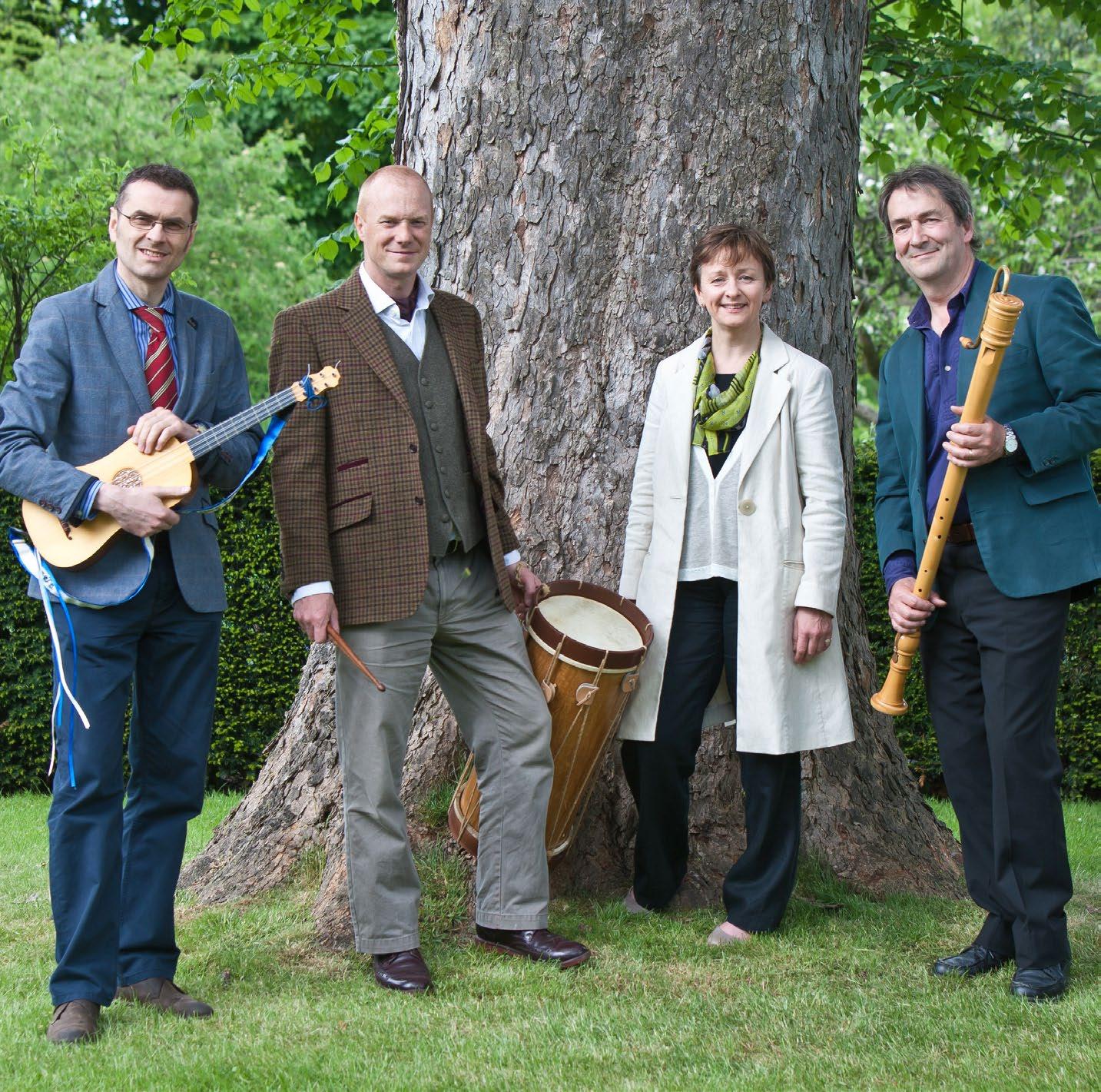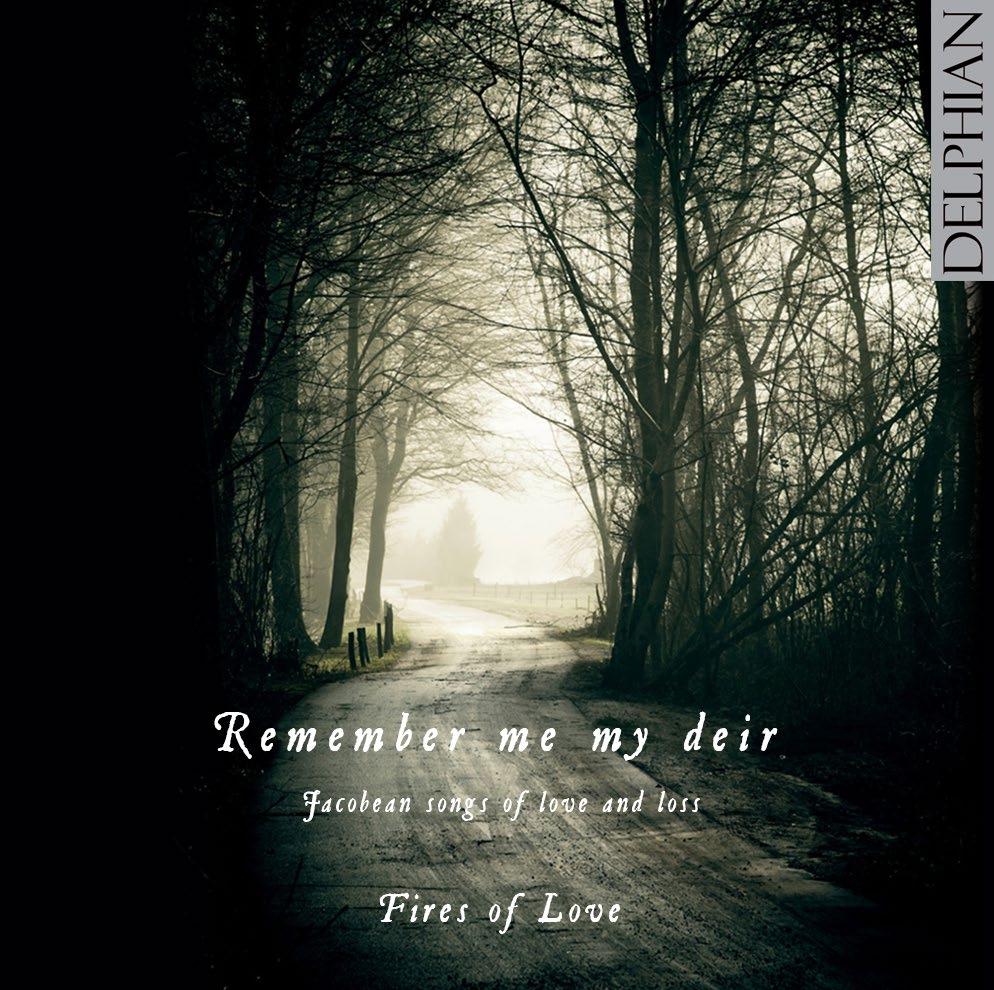
Recorded on 16 & 17 March 2013 in St Margaret’s Chapel, The Gillis Centre, Edinburgh
Producer/Engineer: Paul Baxter
24-bit digital editing: Adam Binks
24-bit digital mastering: Paul Baxter
Cover image: Valentin Casarsa, Dark Road in the Woods © Casarsa/Getty Images Design: Drew Padrutt
Booklet editor: Henry Howard Delphian Records Ltd – Edinburgh – UK www.delphianrecords.co.uk
Gordon Ferries 4-course Renaissance guitar 1 5 9 12 15 16 17 18 22 24 25, lute other tracks
Join the Delphian mailing list: www.delphianrecords.co.uk/join
Like us on Facebook: www.facebook.com/delphianrecords
Follow us on Twitter: @delphianrecords
How should I your true love know (‘Walsingham’)
Bonny sweet Robin (Shakespeare)
Pavane (Passamezzo) and Gagliarda
MS
And will he not come again (Shakespeare) [2:45] (melody based on ‘Mad Tom of Bedlam’, John Sturt MS) Total playing time [62:02]
The music for all tracks is anonymous except where indicated
This recording is dedicated to the memory of Bill Cooper, a much loved father and supporter of our music making.
With thanks to Jonathan Santa Maria Bouquet for life-saving lute repairs and for the kind loan of his lute, a fantastic 8-course instrument after Sextus Rauchwolf, Augsburg, 1596, for tracks 11, 19 and 21. Thanks also to Keith Williamson of Edinburgh University for guidance with old Scots pronunciation and Jamie Reid Baxter for help with glossing the Scots texts.
In April 1603, as King James VI of Scotland prepared to depart for London to take up the crown of England, many Scots must have wondered what would become of their cultural traditions, not least of poetry and song. The two countries were part of a wider European picture, but with very different experiences – and for Scottish poets and musicians, the sixteenth century had been a bruising ride.
Trouble had started forty years before. The Chapel Royal, founded by James IV in 1501, had run against the rock of Reformation in 1560. When Mary Stuart attempted to have mass sung at Holyrood in 1561 there were outraged protests, with ‘broken heads and bloody ears’. In 1571 the great organ at Stirling was dismantled by order of the castle governor. By the 1580s, art music in Scotland was the preserve of consenting adults in private, and the departure of the court for London was another blow.
Yet music had not been impossible. Though French political influence in Scotland fluctuated, French artistic fashions seldom lost their appeal. As a young man in the 1580s, James VI had cultivated both poets and musicians. Much has been made of a ‘veritable academy’ at James’s court known as the Castalian Band; the king was himself supposedly the epicentre, with a gathering of musicians and poets such as Alexander Montgomerie aspiring to revivify Scottish arts much as the neo-classical Pléiade
group of Ronsard, du Bellay et al. had done for France a decade or so earlier. Whether the Castalian Band actually existed is another matter; it has been forcibly argued that the entire notion is a modern myth based on an optimistic misreading of a single line of a poem by King James. Nonetheless, there were authors active in Scotland in the 1580s and 1590s who were alive to the best French models; their love lyrics were being set to music (just as in France), and a discernible style was emerging which resembled the French air.
Song settings of Montgomerie’s poems, such as Quhat mightie motione, have uncomplicated but supple and attractive melodic lines, following strophic patterns. The text is important; although the love conceits are conventional – Cupid’s darts, the eyes as the entrance to the soul – they are put to elegant use in songs such as In throu the windoes of myn ees. Meanwhile, there is poignancy and authenticity in Remember me, my deir. The melodies are often related to dances, and settings are largely chordal. They move with a dignified poise reminiscent of the songs of Claudin de Sermisy. Some Scots songs, such as Andrew Blackhall’s Adeu, O desie of delyt, are arrangements of French tunes.
These qualities shared with French chansons and airs are perhaps typical of songs written by (or for) talented amateurs, the product of a cultivated elite with neo-classical tastes. Lutenists are recorded at the Scottish court from 1474, and
there must have been some professional musicians in the great houses and castles, in spite of Reformation strictures. But we know next to nothing about them; perhaps they kept their heads down. One problem was the lack of a music publishing industry. Music printing on the Continent dates from before 1500; in England, it was underway by the 1520s. But in Scotland the domestic market was tiny and could not support the costs, while Reformation divines frowned upon anything but psalms. Thus the first Scottish printed collection of songs with lyrics only appears in Aberdeen in 1662.
The divines had not been too keen on the theatre either, other than church-sponsored Corpus Christi cycles. There was a visiting company of English actors preparing a show in a close off Edinburgh’s Royal Mile just before James made ready to leave, but we know of little else.
So we must make half-informed guesses; fortunately the preserved manuscript repertoire of Scottish instrumental music is both rich (some four hundred pieces) and in many cases clearly based on an enduring folk tradition. On this recording Gordon Ferries plays some of these on the four-course Renaissance guitar, and some on the lute, an instrument of Arab origin and perhaps originally brought to Scotland by returning Crusaders. The Scottish Huntsupe (or ‘hunt is up’) is markedly Scottish in character; we perform it as a duet, the second lute emphasising the tune’s double-tonic nature, moving up and down
between chords one tone apart, just as much traditional Scottish music does today. Solo reflections such as the Gypsies Lilt and I long for thy virginite could hardly be anything but Scottish. Such tunes are ‘amateurish’ insofar as they are simple, pentatonic, and harmonised often with plain octaves. They are, however, delicate and full of feeling.
Though the Scots inhabited the peripheries of Europe, they were by no means insular. Scots music was spread abroad, sometimes by musical mercenary soldiers such as Tobias Hume. Our Huntsupe appears in the ‘Jane Pickering Lute Book’, a cosmopolitan collection whose binding is decorated with King James’s armorials. A particularly sweet tune is the Canaries, a dance form that began in those islands and spread through Spain, France and Germany, and also Britain. This example is taken from a compilation by Robert Gordon of Straloch, in a manuscript dating from c.1627. Like many Scottish gentry, Gordon of Straloch was partly educated in France, and he found this piece in Jean-Baptiste Besard’s Thesaurus Harmonicus, published in 1603.
In April that year, James and his courtiers headed south, taking a leisurely month to reach London and writing ahead to request their travel expenses. When they arrived, they found a different culture, a world of professional
virtuosi like John Dowland; of famous madrigalists like Morley, Weelkes and Wilbye; and of multi-talented church-based composers like William Byrd and Francis Pilkington who wrote our Rest, sweet nymphs. Far from keeping their heads down, English composers had a sense of professional community and would dedicate pieces to each other (Dowland to Holborne, Pilkington to Dowland), or would write elegies on other’s deaths (Byrd on his master Tallis). Others such as Thomas Campion and Philip Rosseter would work in collaboration; the latter’s When Laura smiles comes from their shared volume.
The English published enthusiastically; all the above composers issued collections. Dowland published airs though never his solo lute music, but he was so famous that others spread it throughout Europe; his pieces appear in numerous manuscripts, one favourite being his variations on the song Go from my window (played here as a song with two lutes). The subject is not far from the old Scots Let me in this ae nicht, but at home the Scots could not get their songs printed at all, while in England Byrd and Tallis published by Royal Licence.
The rapid spread of music publishing indicates a vigorous middle-class market without Reformation qualms, the English gentry (like the Scots) often enjoying novel settings of familiar tunes such as an English Huntsup which originated with Henry VIII. Many English
publications have titles such as ‘Introduction’, ‘Tutor’ or ‘Lessons’. Thomas Morley wrote for his singing club of ‘gentlemen and merchants’, and Campion dedicated his Book of Ayres to amateur musicians, commending its ‘earpleasing rimes without Arte’. Dowland and colleagues still chased noble patrons, but others had alternative means: Campion was a doctor; Rosseter was a theatre manager –although a rather unsuccessful one: he failed to get proper permission for his theatre, and it was demolished by the London authorities.
The London theatre must have startled the Scots newcomers; the level of activity was astonishing, the Globe and Rose stages being run by repertory companies putting on different plays throughout the week. Musicians were a component of each company, with popular tunes woven into the plays. The songs in Hamlet are sung in snatches by poor mad Ophelia; the First Quarto stage direction reads, ‘Enter Ofelia playing on a lute and her hair down singing.’ Her songs include How should I your true love know (‘Walsingham’) – the name of the tune referring to the celebrated Norfolk place of pilgrimage – along with And will he not come again (here played on guitar and lute respectively), and more disreputable numbers such as St Valentine’s Day. Other plays mention dance tunes such as ‘rounds’: ‘Sellinger’s Round’ was widely popular and published later in John Playford’s English Dancing Master. The text sung here is by
Thomas Lodge, published in 1593; the verse scheme is unusual but fits ‘Sellinger’s Round’ perfectly, suggesting an intended match. We believe we know the song melodies used by Shakespeare because, in the early 1800s, two scholars interviewed actresses at Drury Lane who claimed to be preserving the traditional tunes for the plays.
All this musical activity would have been a source of some excitement for the Scots, and perhaps some envy also.
But one aspect would have given them pause: musical and poetic tastes in Scotland were still markedly French; in England the fashion was all for Italy. Italian madrigal styles were studied, Italian verses translated and reset, Italian musical techniques imitated but ‘Englished’. It was from Italy that English composers derived the lute duet, although with local adaptations: the Italians generally used lutes tuned apart from each other, playing two interweaving lines; the English preferred a ground bass with a light treble melody. A leading proponent of lute duets was John Johnson, whose Queen’s Treble is typical.
Few English songwriters employed the French manner favoured by the Scots, but one who did was gifted: Thomas Campion was not only a fine musician; his own lyrics are outstanding.
Campion was an able theoretician, and his Observations on the Art of English Poesie argued for the importation of the French technique of vers mesuré which counts the metre of a line by syllables, not by beats (the English norm), while his musical writings foreshadow changes realised later by French composers including Lully. But Campion’s own efforts to use vers mesuré were not too successful; his Englishmetre The cypress curtain of the night is far better. Had he influenced London taste towards French styles, Campion might have made a space in which the Scots could have flourished. But it was not to be, and soon the Scottish court style of music faded. Any Scottish courtier-musician with James in London after 1603 may have thought regretfully of the north, and of Remember me, my deir.
King James revisited Scotland just once, in 1617, when he commanded that choral services be reinstated in the Chapel Royal. By 1630, resources in Edinburgh were so thin that a newly appointed director of music, Edward Kellie, was obliged to travel to London to see how services were run, to buy music, and to engage an organist, cornett and sackbutt players and even singers, so few being available in the north.
So, had the Union of Crowns dealt a fatal blow to Scottish music, after its Reformation
wounds? No, for that would be to look in the wrong places. There was, certainly, a vacuum at the centre. But in other cities (Aberdeen, for instance), and among the folk great and small, and in fine houses around the country – less accessible in an age of dire communications, and so more self-reliant in their entertainments – there the traditions continued. Portraits of the Scots nobility show them holding lutes of considerable size and sophistication long into the 1600s, at which time the Scottish lute manuscripts still contained French dance tunes but also pieces in common with popular English collections such as Playford’s English Dancing Master. Ironically, by the mid 1600s Scottish tunes were all the rage in the south – so much so that after 1700 whole volumes of these were published in London: not the French-born high style of Montgomerie and friends, but the lively dances, the folk songs and the ‘huntsupe’.
© 2013 Jonathan Hugh-Jones
1 And will he not come again? And will he not come again? No, no, he is dead!
Go to thy death-bed, He never will come again.
His beard was as white as snow, All flaxen was his poll. He is gone, he is gone, And we cast away moan. God ha’ mercy on his soul.
William Shakespeare (1564–1616), Hamlet, Act IV, scene v
4 Rest, sweet nymphs, let golden sleep Charm your star brighter eyes, Whiles my lute the watch doth keep With pleasing sympathies.
Lulla lullaby, Lulla lullaby, Sleep sweetly, sleep sweetly, Let nothing affright ye, In calm contentments lie.
Thus dear damsels I do give Good night and so am gone. With your heart’s desires long live, Still joy, and never moan.
Lulla lullaby, Lulla lullaby Hath pleased you and eased you, And sweet slumber seized you. And now to bed I hie. anon.
5 ‘Tomorrow is St Valentine’s Day All in the morning betime, And I a maid at your window To be your Valentine.’
Then up he rose and donned his clothes And dupped the chamber door, Let in the maid that out a maid Never departed more.
By gis and by St Charity, Alack and fie for shame! Young men will do it if they come to’t –By cock, they are to blame.
Quoth she, ‘before you tumbled me, You promised me to wed.’ ‘So would I had done, by yonder sun, And thou hadst not come to my bed.’
Hamlet, Act IV, scene v
7 Go from my window, my love, Go from my window, my dear.
O, the weather it is warm, It will never do you harm, You cannot be lodged here.
O, the wind is rising high, And the ship is lying by, You cannot be lodged here.
O, the wind and the rain, They have fetched him back again, He cannot be lodged here.
O, the Devil’s in the man, And he will not understand That he can’t have a lodging here. anon.
9 O sweet Oliver, O brave Oliver, Leave me not behind thee, Wind away, begone I say, I will not wedding with thee.
Shakespeare, As You Like It, Act III, scene iii
My bonny lass, thine eye So sly Hath made me sorrow so: Thy crimson cheeks, my dear, So clear, Have so much wrought my woe.
Thy pleasing smiles and grace, Thy face, Have ravished so my sprites, That life is grown to nought Through thought Of love which me affrights.
I should consume to nought, Through thought Of thy fair shining eye, Thy cheeks, thy pleasing smiles, The wiles That forced my heart to die. Thomas Lodge (1558–1625)
10 In throu the windoes of myn ees, Ane open and a pairrlous pairt, Hes Cupid hurt my hevy hairt, Quhilk daylie duyns, bot nevir dees, Throu poyson of his daidly dairt. I bad him bot to sey ane shot; I smyld to se that suckling shute: ‘Boy, with thy bou do vhat thou dou,’ Quod I, ‘I cair thee not a cute.’
‘Fell peart,’ quod Cupid, ‘thou appeirs:’
Syn to his bou he maid a braid And shot me soon be I had said; Quhill all my laughter turn’d to teirs.
‘Now gesse,’ quod he, ‘if thou be glaid; Now laugh at Love, that pastym prove: Am I ane archer nou or nocht?’ His skorne and skayth, I baid them baith, And got it sikker that I socht.
Go once, my longsome looks, reveill My secrete to my lady sueet; Go, sighs and teirs, for me intreet, That sho, by sympathie, may feill Pairt of the passionis of my spreet. Than, if hir grace givis pittie place, Ineugh; or covets sho to kill, Let death dispetch my lyf, puir wretch! I wold not live aganst hir will.
Alexander Montgomerie (c.1550–1598)
v.1: duyns – dwindles away; sey – attempt; suckling –infant; dou – can; not a cute – not a jot v.2: fell peart – very cheeky; maid a braid – strung his bow; skayth – harm; got it sikker… – certainly got what I was asking for v.3: sho – she
12
Remember me, my deir, I humbly you requeir
For my request that loves you best
With faithfull hart inteir.
My hart sall rest within your breist, Remember me, my deir.
Remember me, deir hart
That of pains hes my part.
Your words unkind sinks in my mind
And dois increase my smart; Yet shall ye find me true and kind!
Remember me, deir hart.
anon.
14 When Laura smiles her sight revives both night and day.
The earth and heaven views with delight her wanton play.
And her speech with ever-flowing music doth repair
The cruel wounds of sorrow and untamed despair.
The sprites that remain in fleeting air Affect for pastime to untwine her tressed hair.
And the birds think sweet Aurora, Morning’s Queen, doth shine
From her bright sphere, when Laura shows her looks divine.
Diana’s eyes are not adorned with greater power
Than Laura’s when she lists awhile for sport to lure:
But when she her eyes encloseth, blindness doth appear
The chiefest grace of beauty, sweetly seated there.
Love hath no fire but what he steales from her bright eyes.
Time hath no power but that which in her pleasure lies:
For she with her divine beauties all the world subdues, And fills with heav’nly spirits my humble muse.
anon., sometimes attr. to Thomas Campion (1567–1620), perhaps by Philip Rosseter (1567/8–1623)
16 Adeu, o desie of delyt;
Adeu, most plesand and perfyt; Adeu, and haif gude nicht: Adeu, thou lustiest on lyve; Adeu, suete thing superlatyve; Adeu, my lamp of licht!
Lyk as the lyssard does indeid
Leiv by the manis face, Thy beutie lykuyse suld me feid
If we had tyme and space. Adeu nou; be treu nou, Sen that we must depairt. Foryet not, and set not
At licht my constant hairt.
Albeit my body be absent My faithfull hairt is vigilent
To do you service true; Bot vhen I hant into the place Quhair I wes wont to sie that face My dolour does reneu. Then all my plesur is bot pane My cairis they do incres; Vntill I sie your face agane I live in hevynes.
Sair weeping, but sleeping The nichts I ouerdryve; Quhylis murning, vhylis turning With thoghts pensityve.
O lady, for thy constancie, A faithfull servand sall I be, Thyn honour to defend; And I sall surelie, for thy saik As doth the turtle for her maik Love to my lyfis end. No pene nor travell, feir, nor dreid Sall caus me to desist. Then ay when ye this letter reid Remember hou we kist; Embracing, with lacing, With others teiris sueet, Sik blissing in kissing I quyt till we tua meit.
Montgomerie
v.1: desie – daisy; on lyve – alive; lyk as the lyssard … – a reference to the mythological claim that lizards (e.g. basilisks) suck their life out of men’s faces by gazing on them
v.2: hant into – frequent; ouerdryve – spend
v.3: maik – mate; lacing – entwining; sik blessing –such imparting of bliss
17 How should I your true love know
From another one?
By his cockle hat and staff And his sandal shoon.
He is dead and gone, lady, He is dead and gone.
By his feet a grass-green turf, By his head a stone.
White his shroud like the mountain snow, Larded with sweet flowers, Which bewept to the grave did go With true-love showers.
Hamlet, Act IV, scene v
18 Ophelia: There’s fennel for you, and columbines. There’s rue for you. And here’s some for me. We may call it herb of grace a Sundays. You must wear your rue with a difference. There’s a daisy, but they withered all when my father died. They say a made a good end. (Sings) For bonny sweet Robin is all my joy.
Hamlet, Act IV, scene v
20 The cypress curtain of the night is spread, And over all a silent dew is cast. The weaker cares by sleep are conquered; But I alone, with hideous grief aghast, In spite of Morpheus’ charms a watch do keep, Over mine eyes, to banish careless sleep.
Grief, seize my soul, for that will still endure When my crazed body is consumed and gone; Bear it to thy black den, there keep it sure, Where thou ten thousand souls dost tire upon: Yet all do not afford such food to thee As this poor one, the worser part of me.
Campion
v.1: cypress – black crape cloth for mourning v.2: tire – tear and prey upon
22 Quhat mightie motione so my mynd mischievis?
Quhat vncouth cairs throu all my corps doth creep?
Quhat restles rage my resone so bereivis? Quhat maks me loth of meit, of drink, of sleep?
I knou not nou vhat countenance to keep For to expell a poysone that I prove. Alace! alace! that evir I leirn’d to love.
My hopeless hairt, vnhappiest of hairts, Is hoild and hurt with Cupid’s huikit heeds And thirlit throu with deidly poysond dairts
That inwardly within my briest it bleids. Yit fantasie my fond affection feeds, To run that race but ather rest or rove
Alace! alace! that evir I leirn’d to love.
All gladnes nocht but aggravats my grief; All mirrines my murning bot augments. Lamenting toons best lyks me for relief, My sickness soir to sorou so consents; For cair the cairfull commounly contents; Sik harmony is best for their behove.
Alace! alace! that evir I leirn’d to love.
Montgomerie
v.1: corps – body; loth of meit – lacking appetite
v.2: huikit – hooked; thirlit – pierced; ather – either
v.3: toons – tones (of music); behove – requirements
25 And will he not come again
See track 1
Fires of Love
Fires of Love was formed in 1998 with the aim of performing Renaissance and early Baroque chamber music in a fresh, innovative and accessible style, bringing lesser-known compositions to a wider audience. Based in Scotland, the quartet has performed in venues and festivals around Britain.
The repertoire centres on lute and guitar songs, set amongst instrumental ensembles, solos, recent discoveries and the group’s own arrangements. The music spans the breadth of Europe: the unique voice of the Spanish Renaissance, the royal courts of sixteenth and seventeenth-century war-torn France, the flowering of the Italian Baroque and the golden age of Elizabethan and Jacobean lute song. Instruments include lutes, archlute, theorbo, vihuela, baroque guitar, four-course guitar, recorders and percussion.
The group has made two previous recordings for Delphian: Love and Reconquest: Music of Renaissance Spain (DCD34003) and Chansons à Plaisir: Music from the time of Adrian Le Roy (1520–1598) (DCD34063), both released to high critical acclaim.
www.firesoflove.co.uk
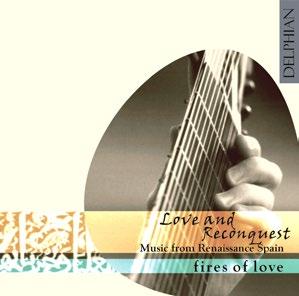
Love and Reconquest: Music of Renaissance Spain
Fires of Love
DCD34003
Scottish early music ensemble Fires of Love serves up a feast of songs and ballads from the Spanish Renaissance and early Baroque, with a freshness critic Norman Lebrecht calls simply ‘beautiful’. Repertoire includes works by Luys de Narváez, Miguel de Fuenllana, Luis Milán, Alonso Mudarra and Juan del Encina.
‘another well-produced disc from the Edinburgh-based company Delphian, which, to its credit, is reaching those parts of the repertoire many of the bigger boys fail to reach’
– The Scotsman, January 2002
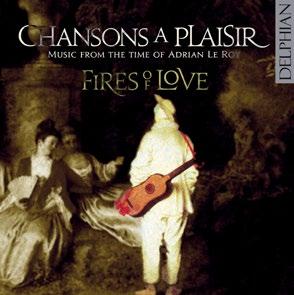
Chansons à Plaisir: Music from the time of Adrian Le Roy (1520–1598) Fires of Love
DCD34063
Amid religious strife and social turmoil, the sixteenth century also saw France emerge as a humanist culture with a unique musical voice. This world of contrasts provided the perfect setting for Adrian Le Roy to flourish as a composer, performer and publisher. Scottish ensemble Fires of Love vividly recreate the many facets of his musical world, from vivacious dances to songs of utmost sorrow.
‘songs and instrumental dances performed with a refined temperament well suited to the languid style of the period’
– The Scotsman, March 2008
‘Lovely music, lovely singing’
– Early Music Review, April 2008
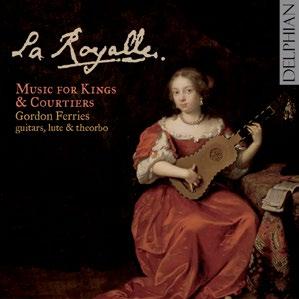
La Royalle: Music for Kings and Courtiers
Gordon Ferries Baroque & Renaissance guitars, lute & theorbo
DCD34111
Performed on four instruments matched to the periods in question, and captured in sumptuous recorded sound, Gordon Ferries’s most recent solo recital spans two centuries of music with royal connections – from the chansons and elegant counterpoint of sixteenth-century France’s cultivated humanist courts and the exquisitely melancholy dance-forms heard in the private chambers of Versailles, to the extraordinary place of guitar music amid the decadence, sexual intrigue and Baroque splendour of Restoration England. The Italian-born composer and guitarist Francesco Corbetta (1615–1681) served both Charles II and his cousin Louis XIV, and his music provides a common thread.
‘subtle, rich and probing … The disc is beautifully produced’ – International Record Review, February 2013
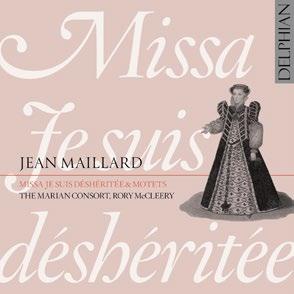
Jean Maillard (fl. 1538–70): Missa Je suis déshéritée & Motets
The Marion Consort, Rory McCleery
DCD34130
Jean Maillard’s life is shrouded in mystery, and his music is rarely heard today. Yet in his own time his works were both influential and widely disseminated: indeed, the musicologist François Lesure held him to be one of the most important French composers of his era. Who better, then, than The Marian Consort and Rory McCleery, a scholar as well as an acclaimed performer, to give this composer’s rich and varied output its first dedicated recording? Their characteristically precise and yet impassioned performances bring out both the network of influence in which Maillard’s music participated – its Josquinian pedigree, and influence on successors including Lassus and Palestrina – and its striking, individual beauty.
‘The performances are models of discretion and musical taste, every texture clear, every phrase beautifully shaped’
– The Guardian, October 2013
